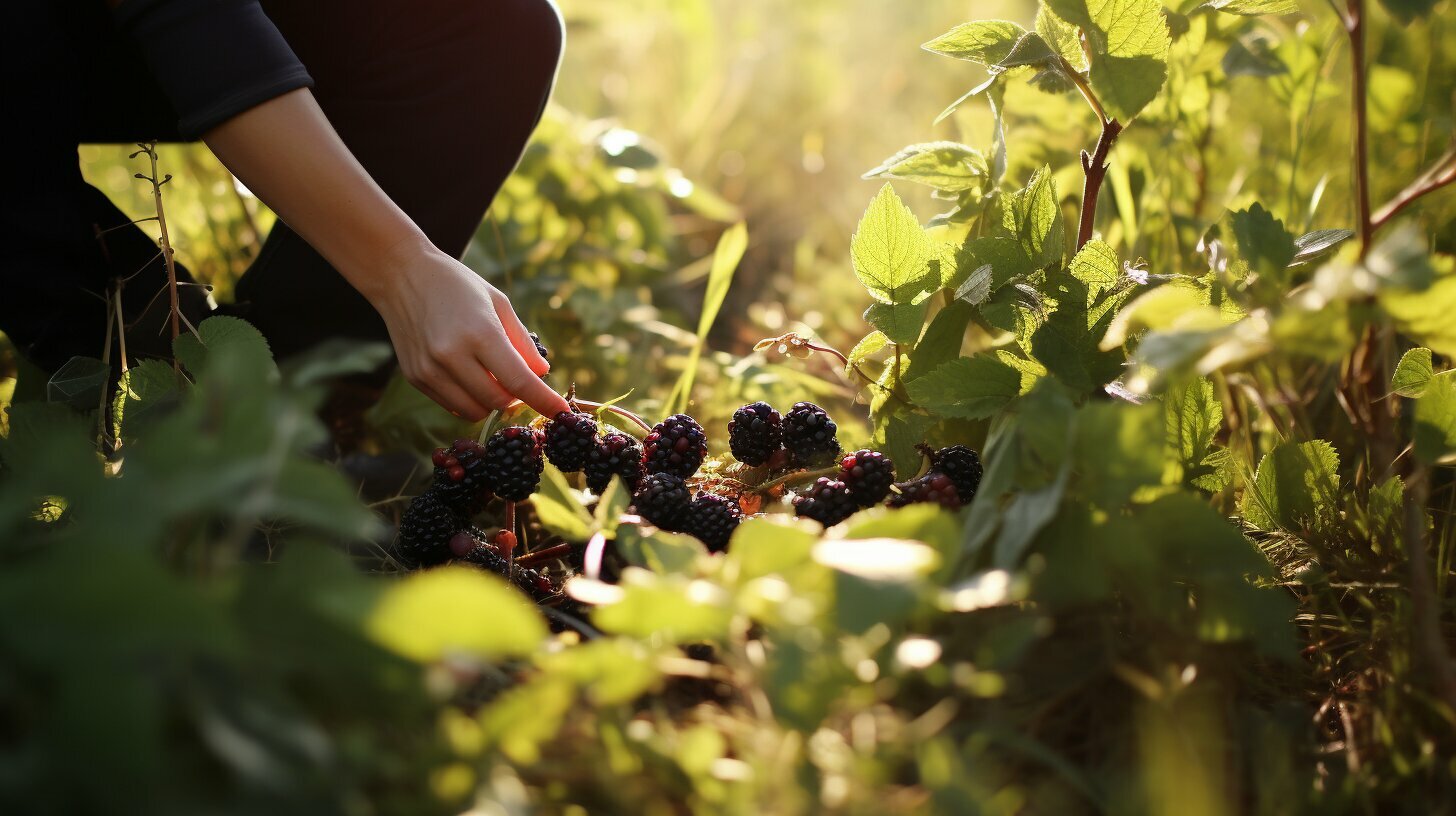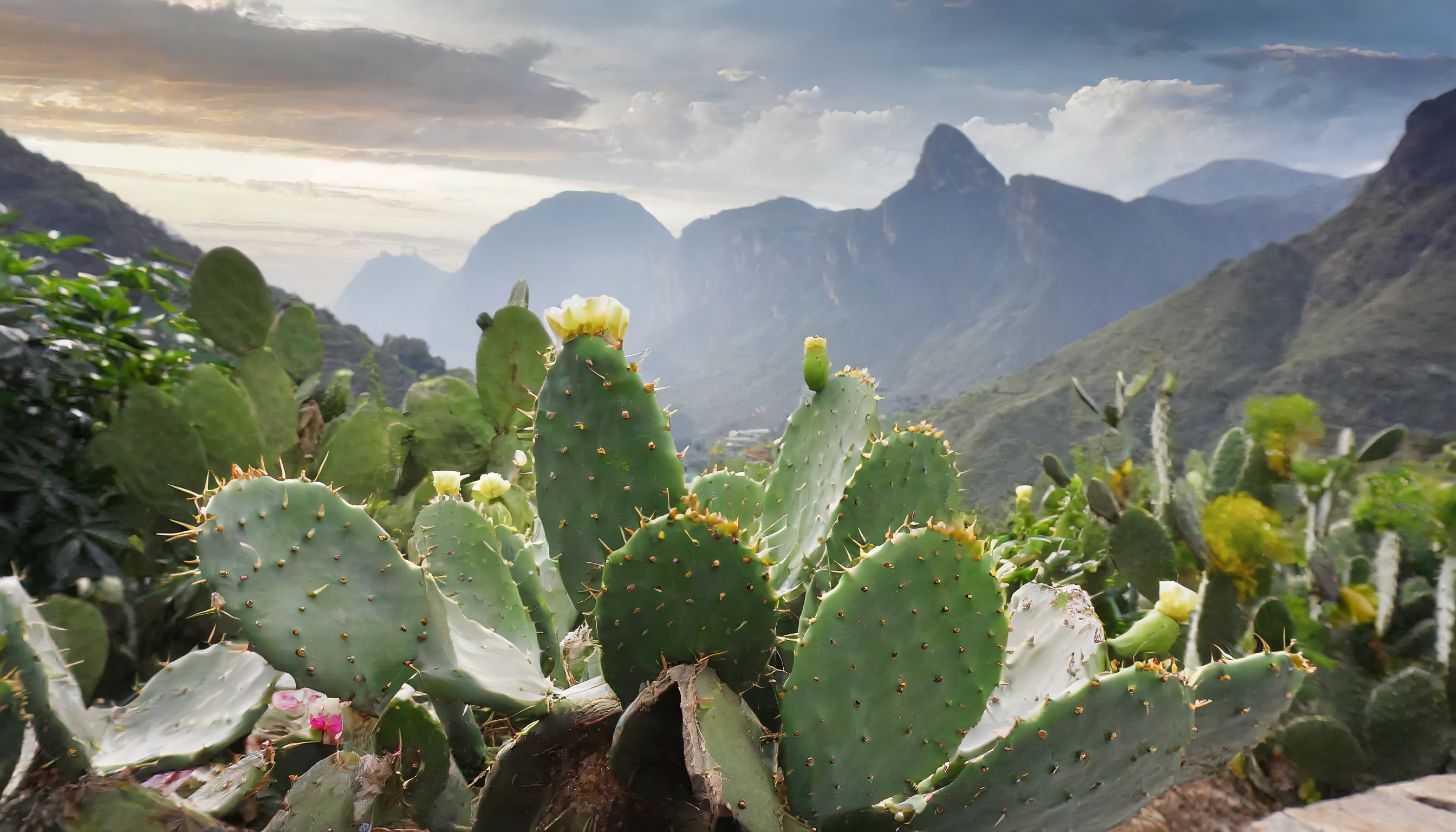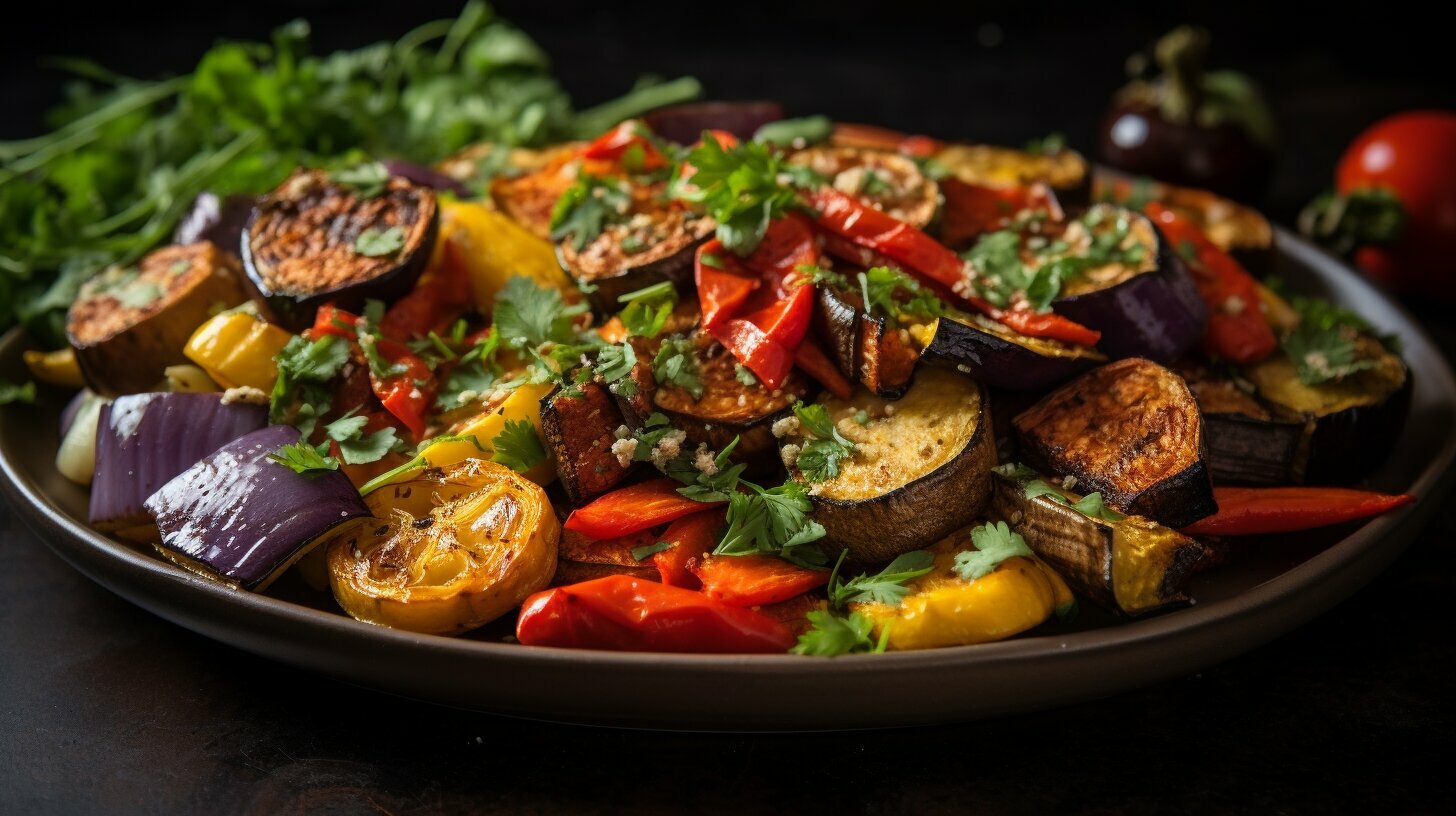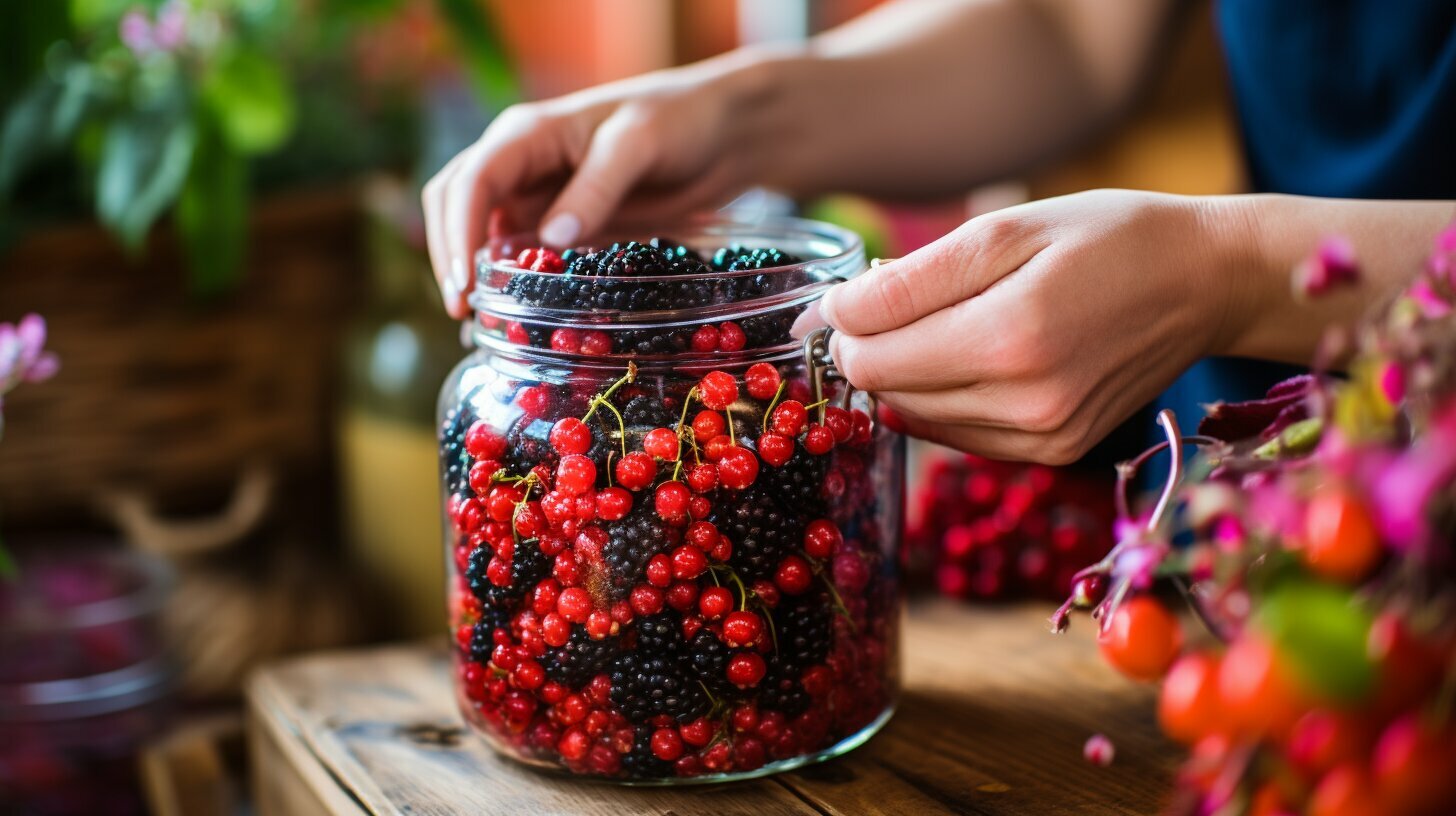If you’re looking for a new outdoor adventure, why not explore the world of wild blackberry foraging? Not only is it a fun and rewarding activity, but you’ll also get to enjoy the delicious fruits of your labor.
Wild blackberries are found in many regions throughout the United States, making it easy to find a prime spot for foraging. Whether you’re a seasoned forager or a beginner, there’s something for everyone in the world of blackberry picking.
Key Takeaways
- Wild blackberry foraging is a fun and rewarding outdoor activity.
- Blackberries are found in many regions throughout the United States.
- Whether you’re a seasoned forager or a beginner, there’s something for everyone in the world of blackberry picking.
Exploring the world of wild blackberries
Foraging for wild blackberries is a thrilling experience that involves exploring nature’s bounty. But before you set out, it’s important to learn about the different blackberry species and how to identify them in the wild.
The most common blackberry species in North America are the Allegheny blackberry, the Evergreen blackberry, the Himalayan blackberry, and the Pacific blackberry. Each species has its distinct physical features, such as leaf shape, stem color, and fruit size and color.
Disclosure: When you buy through links on our site, we may earn an affiliate commission.
To identify wild blackberries, look for shrubs with thorny stems and clusters of small white or pink flowers in the spring. As the flowers fade, they give way to immature green berries that gradually ripen to a rich, dark hue in the late summer or fall.
Tip: Use caution when identifying blackberries, as some poisonous species, such as the nightshade, may look similar. When in doubt, consult a local expert or field guide.
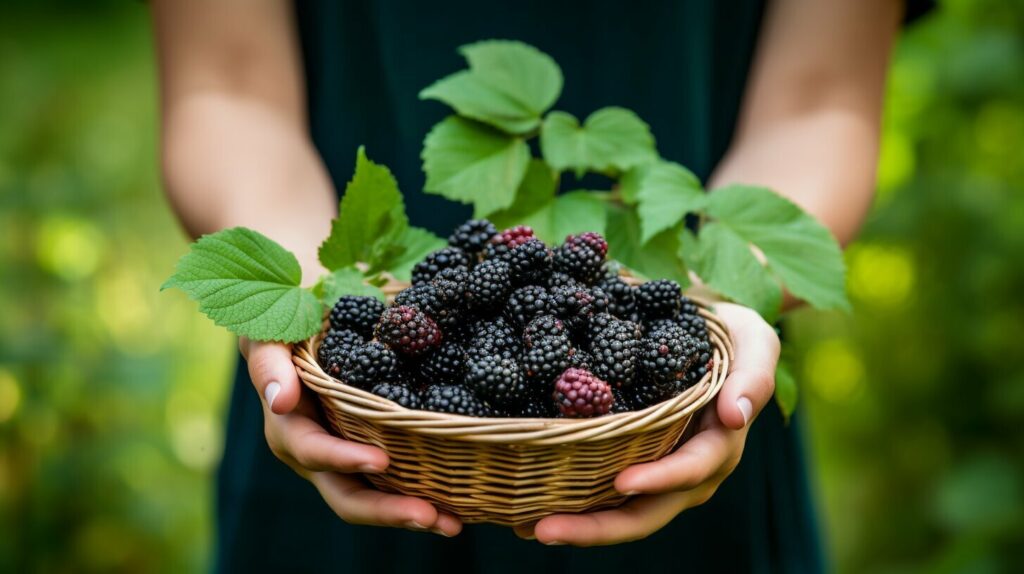
When you’re out in the field, keep in mind that wild blackberries grow in varied terrain, such as sunny fields, forest edges, and along waterways. Look for areas with ample sunlight and good drainage, as blackberries thrive in these conditions. Keep an eye out for ripe berries that are plump, shiny, and firm to the touch.
Tip: Always bring a container or basket to collect your blackberries. Not only does it make for easier transport, but it also helps prevent squishing the delicate fruit.
Getting started with wild blackberry foraging
Are you ready to embark on your first wild blackberry foraging adventure? Here are some tips to help you get started:
- Timing is everything: Blackberries are ripe for picking from late summer to early fall. The best time to go foraging is in the early morning or late afternoon when the sun is not too hot.
- Location, location, location: Look for blackberry bushes in the countryside, along hiking trails or in parks, and avoid areas with heavy pesticide use. Blackberries grow in sunny areas and thrive in soil that is moist and well-drained.
- Bring the right equipment: Wear long sleeves, long pants, and gloves to protect yourself from thorns and ticks. Bring a bucket or a basket to collect your blackberries and a pair of pruning shears to cut the stems cleanly.
- Identify the right berries: Know your blackberries! Look for plump, juicy berries with a dark, shiny color. Avoid picking berries that are soft, discolored, or moldy. Be careful not to confuse blackberries with other similar-looking berries that may be poisonous.
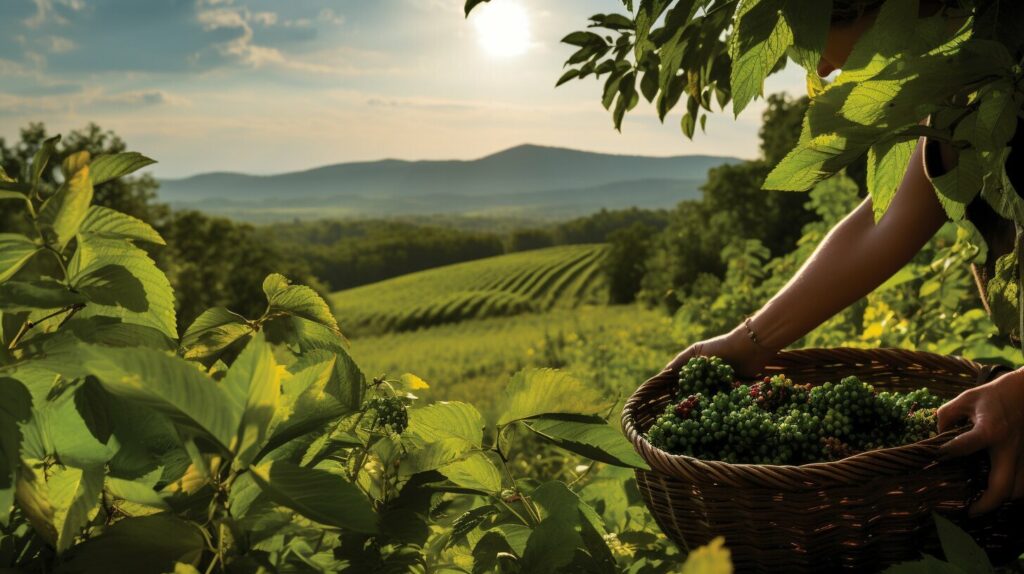
The Best Places to Forage for Blackberries in the US
If you’re looking for prime blackberry foraging spots in the United States, you’re in luck. From coast to coast, there are plenty of places where you can find wild blackberries just waiting to be picked. Here are some of the top locations to add to your foraging bucket list:
| Region | Location | Why It’s Great |
|---|---|---|
| Pacific Northwest | Oregon, Washington, and Idaho | The moist, cool climate of the Pacific Northwest creates ideal growing conditions for wild blackberries. Look for them in coastal areas, along hiking trails, and in abandoned lots. |
| Midwest | Michigan, Ohio, and Indiana | The Midwest is home to both trailing and erect blackberry varieties. You can find them growing in open fields, along roadsides, and in abandoned lots. |
| South | Alabama, Louisiana, and Georgia | The warm climate of the Southern states makes for a longer growing season for wild blackberries. Check out wooded areas, along creek beds, and in abandoned fields for prime blackberry patches. |
| Northeast | New York, Pennsylvania, and New England | The Northeast is home to both wild blackberries and their close cousin, the black raspberry. Look for them along hiking trails, in wooded areas, and along the edges of fields. |
| West | California and Colorado | The West has a unique climate that allows for both trailing and erect blackberry species to thrive. Look for them along creek beds, in meadows, and in abandoned lots. |
These are just a few of the many regions in the United States where you can find wild blackberries. Remember to always gain permission before foraging on private property, and respect any rules and regulations in place.
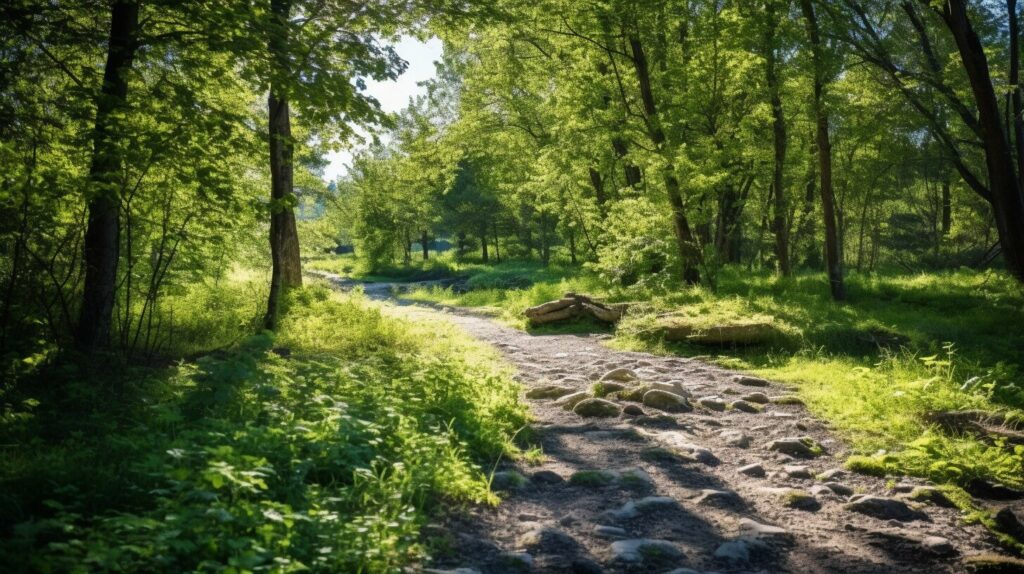
Wild Blackberry Picking Season
One of the joys of wild blackberry picking is the opportunity to enjoy fresh, juicy berries straight from the bush. However, to ensure a successful foraging experience, it’s important to know when and where to find ripe blackberries.
Blackberry picking season typically spans from mid-July through August, with peak ripeness varying by region. In the Pacific Northwest, blackberries may be available as early as June, while in the Midwest and Northeast, peak season is usually in August.
When scouting for blackberries, keep an eye out for bushes with plump, shiny blackberries that come off the stem easily. Avoid berries that are still red or partially green, as they may not yet be fully ripe. It’s also important to wear appropriate clothing and bring along plenty of water to stay hydrated during your foraging adventure.
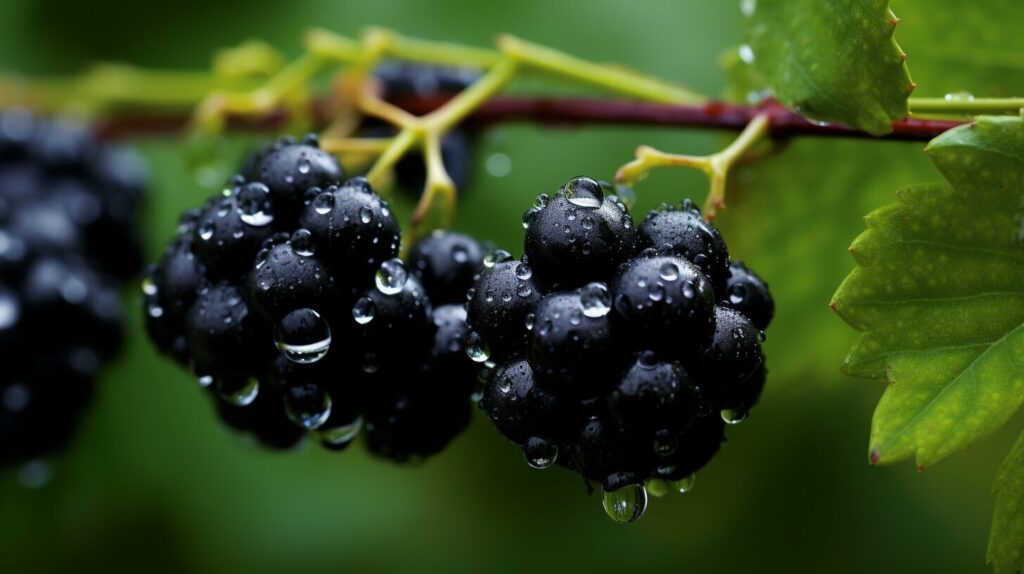
Whether you’re foraging in your own backyard or embarking on a road trip to a prime blackberry-picking location, the experience of discovering and harvesting your own wild blackberries is a rewarding one.
Wild Blackberry Recipes
After a successful blackberry foraging trip, you’ll likely have an abundance of these juicy berries to enjoy. Here are some delicious recipes to try:
| Recipe | Description |
|---|---|
| Blackberry Pie | A classic dessert that showcases the sweet and tart flavors of blackberries. Serve warm with a scoop of vanilla ice cream. |
| Blackberry Jam | A great way to preserve your blackberry harvest, this jam can be enjoyed on toast, muffins, or as a topping for yogurt or oatmeal. |
| Blackberry Smoothie | A refreshing and healthy beverage that combines fresh blackberries with yogurt, almond milk, and honey. |
| Blackberry Mojito | A fun and fruity cocktail that features muddled blackberries, lime juice, mint leaves, and rum. |
Get creative with your blackberry harvest and experiment with different recipes to find your favorites. Whether you prefer sweet or savory dishes, there’s no shortage of ways to enjoy these versatile berries.
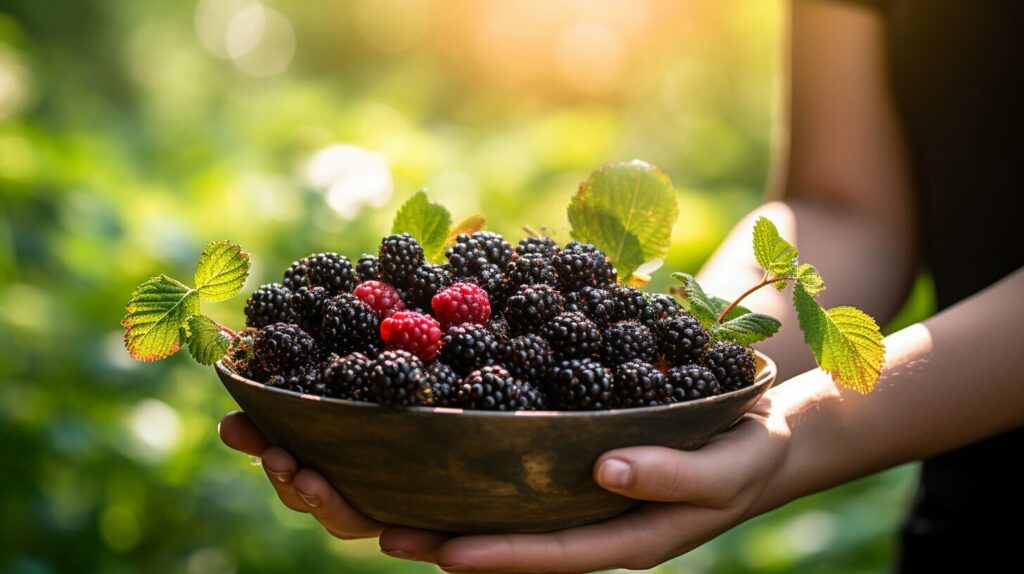
Tips for a Sustainable Foraging Experience
Foraging for wild blackberries can be a fun and rewarding activity, but it’s important to do so in a sustainable manner. Here are some tips to ensure that you’re taking care of both the environment and the blackberry patches you’re foraging from:
- Be respectful of the environment: When foraging, make sure to leave the area exactly as you found it. Avoid trampling on plants, disturbing wildlife, or leaving any trash behind.
- Only take what you need: It’s important to only harvest what you plan on using. Taking more than you need can reduce the amount of berries available for other foragers and wildlife.
- Don’t overharvest: Be mindful of how many berries you’re taking from a single patch. If too many berries are harvested from one area, it can harm the growth and regeneration of the plant for future years.
- Avoid areas with pesticide use: Pesticides can be harmful to both you and the environment. Avoid areas where pesticides have been used, and always make sure to wash your berries thoroughly before consuming them.
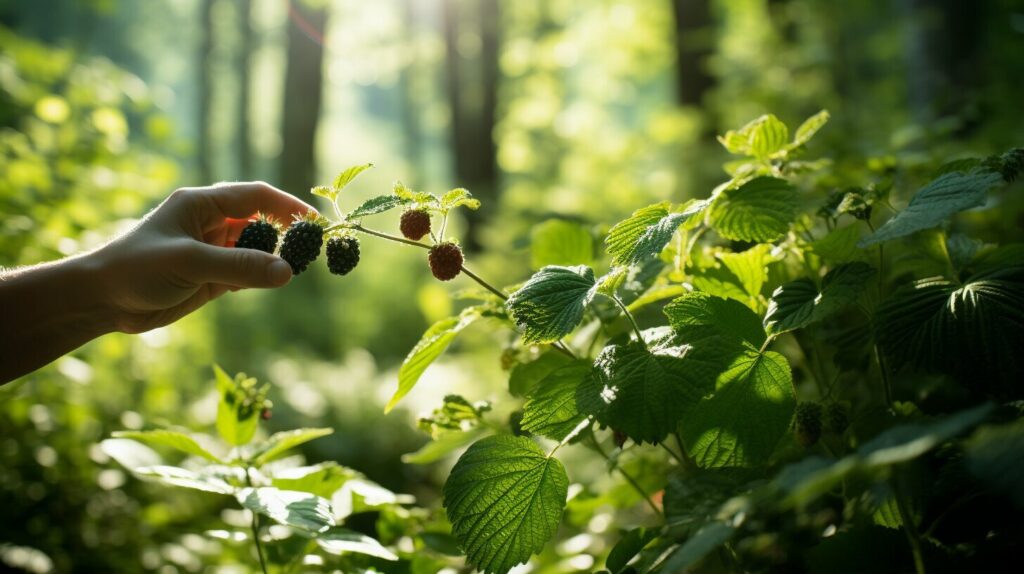
Health Benefits of Wild Blackberries
Blackberries are not only delicious but also packed with nutrients that can benefit your health.
For starters, wild blackberries are a rich source of antioxidants, which protect your body’s cells from damage caused by free radicals. This can lower your risk of chronic diseases such as cancer and Alzheimer’s.
Additionally, blackberries are high in fiber, which promotes digestive health and can help prevent constipation. They are also a good source of vitamin C, which supports a healthy immune system and can reduce the risk of infections.
What’s more, blackberries are low in calories and carbohydrates, making them a great choice for people who are watching their weight or managing their blood sugar levels.
Whether you enjoy them fresh off the bush or incorporate them into recipes, wild blackberries are a tasty and nutritious addition to your diet.
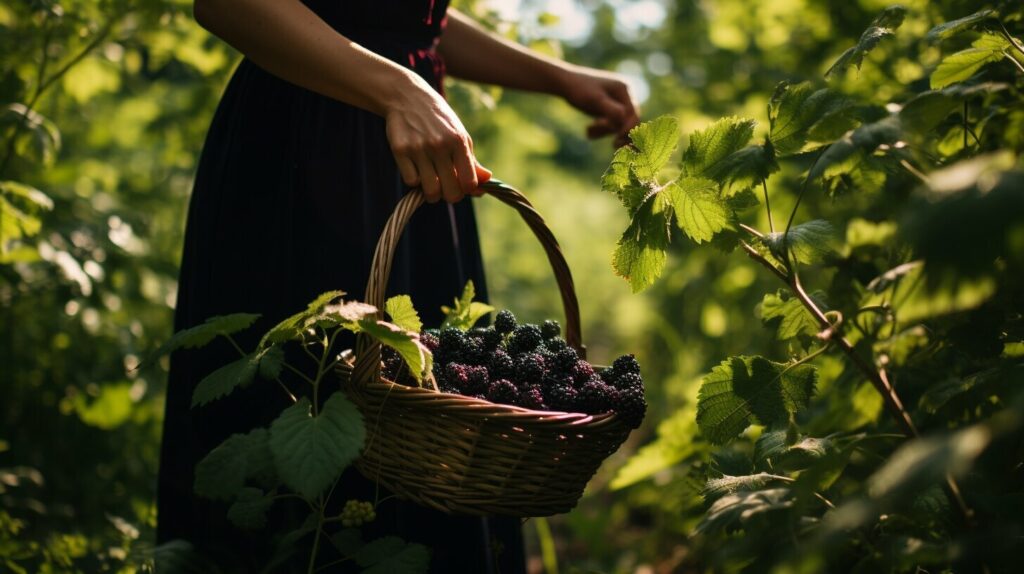
Precautions to take when foraging for wild blackberries.
Wild blackberry foraging can be a fun and rewarding experience, but it’s important to take certain precautions to ensure your safety and the preservation of the environment.
Wear appropriate clothing: When heading out to forage, wear long pants and sleeves, sturdy closed-toe shoes, and gloves to protect yourself from scratches and potential hazards such as thorns and poison ivy.
Be aware of potential hazards: Keep an eye out for potential hazards such as uneven terrain, steep drops, and wildlife. It’s important to be aware of your surroundings and use caution when navigating through the wild.
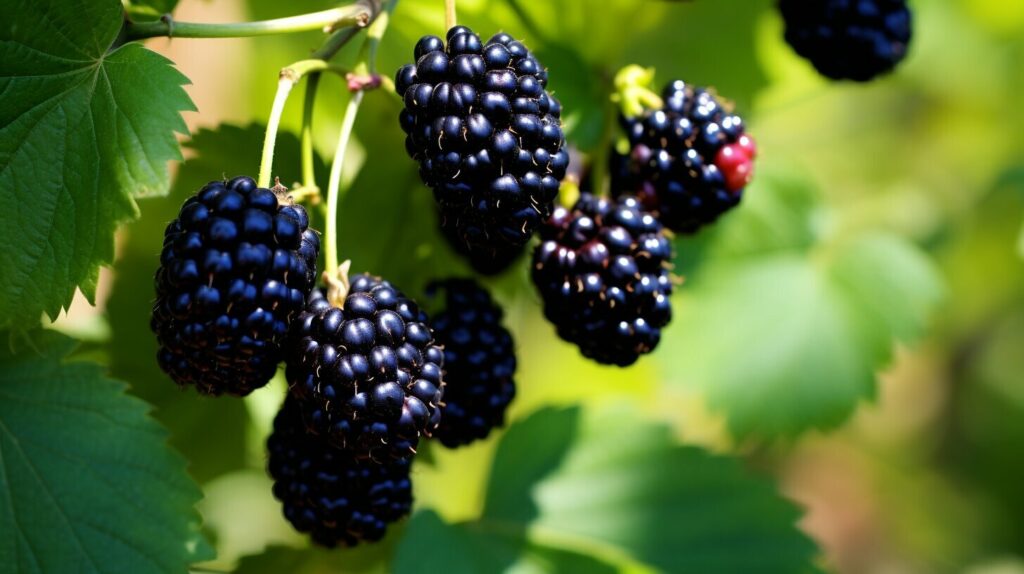
Enjoying the fruits of your foraging labor
Congratulations on your successful wild blackberry picking adventure! Now that you have your freshly picked blackberries, it’s time to enjoy them to the fullest.
To preserve your blackberries for later use, gently rinse them in cool water and pat them dry with a clean towel. Store them in a single layer in a shallow container, and place them in the refrigerator. Blackberries can last up to a week when stored properly.
If you want to enjoy your blackberries right away, there are countless delicious ways to prepare them. One popular option is to make blackberry jam, which can be spread on toast, used as a topping for ice cream, or incorporated into baked goods. Another option is to make a refreshing blackberry smoothie by blending blackberries with yogurt, ice, and honey.
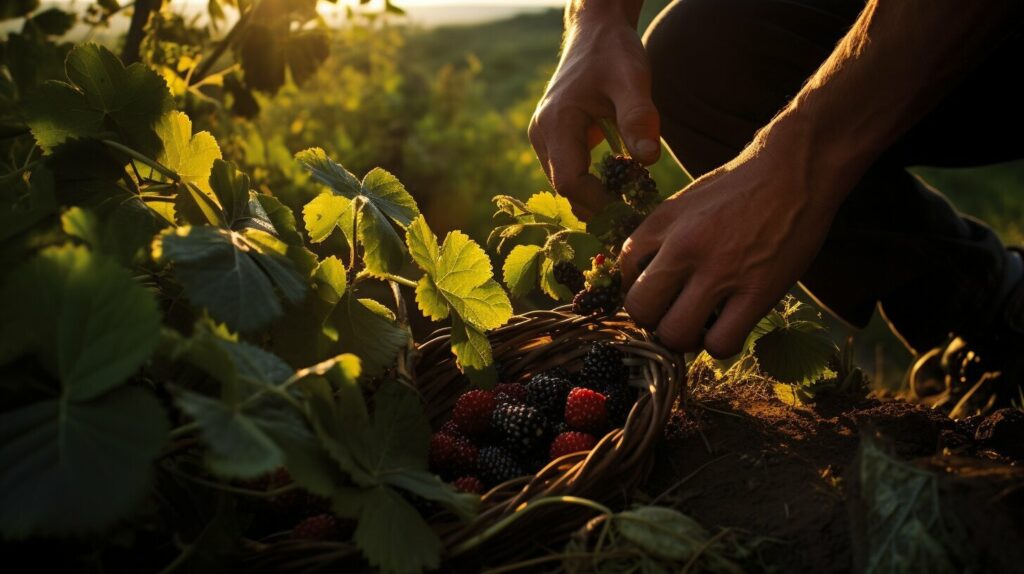
If you’re feeling adventurous, you can also try making blackberry cocktails, such as a blackberry mojito or blackberry margarita. And of course, blackberries are perfect for baking – try making a blackberry pie or crisp for a delicious dessert.
Whatever method you choose, make sure to savor the sweet and tart flavors of wild blackberries – they’re a true delight for the senses.
Conclusion
Now that you’ve explored the world of wild blackberry foraging, it’s time to unleash your inner gatherer and start picking. The benefits of this outdoor activity are numerous, from the thrill of the hunt to the nutritious and delicious rewards.
Remember to follow the tips and precautions we’ve provided to ensure a safe and sustainable foraging experience. And once you’ve gathered your blackberry bounty, get creative in the kitchen with our mouthwatering recipes.
So what are you waiting for? Grab a basket and head out to the best places to forage for blackberries in your area. With a little patience, perseverance, and a keen eye, you’ll be on your way to a fruitful and fulfilling wild blackberry picking adventure.
FAQ
Q: Can I forage for wild blackberries anywhere?
A: Wild blackberries can be found in many regions, particularly in North America. However, it’s important to obtain proper permission or access rights before foraging on private or protected lands.
Q: When is the best time to go blackberry picking?
A: The prime season for blackberry foraging is typically in the summer months, from late June to early August. This is when blackberries are ripe and most abundant.
Q: How do I identify wild blackberries?
A: Wild blackberries typically have thorny canes, white or pale pink flowers, and dark purple or black berries. It’s important to be confident in your identification skills or consult a reputable field guide to ensure you’re picking the right berries.
Q: Are there any safety precautions I should take when foraging for wild blackberries?
A: Yes, it’s important to wear long sleeves, pants, and closed-toe shoes to protect yourself from thorns and ticks. Avoid areas that have been sprayed with pesticides, and be cautious of wildlife such as snakes or bears.
Q: What can I do with the blackberries I’ve picked?
A: There are endless possibilities! You can enjoy the blackberries fresh, make delicious recipes like pies, jams, or smoothies, or freeze them for future use.
Q: How can I ensure a sustainable foraging experience?
A: To be sustainable, only pick what you will use or share with others. Leave some berries behind for wildlife and future foragers. Only forage in areas where it’s allowed and be respectful of the environment.
Q: Are there any health benefits to consuming wild blackberries?
A: Absolutely! Wild blackberries are rich in antioxidants, vitamins, and fiber. They can help boost your immune system, support digestive health, and contribute to overall well-being.
Q: Can I store wild blackberries for later use?
A: Yes, you can store freshly picked blackberries in the refrigerator for a few days. If you want to preserve them for longer, consider freezing, canning, or making jams and jellies.

